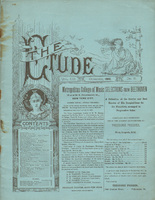The gavotte, or gavot, originated in the dance of the Gavots, or men of the Pays de Gap, who inhabit a town of that name in Upper Dauphiny, in France, so says an exchange. At a certain period, as a social dance, it is very much used. A celebrated contemporary of Handel, named Mattheson (1681-1764) says, with reference to the gavotte, “The expression should be that of a right jubilant joy.” The “jumping” movement is a particular feature of it, and by no means the “running.” All gavottes are not accompanied by the musette, the particularity of which is that the fundamental or “drone” bass never changes, thus imitating the quaint, monotonous sound of the bagpipe; but the addition of the musette affords variety, thus relieving a composition which may have to be constantly repeated of a monotony which after a time would otherwise become somewhat tiresome. Cotgrave calls the gavotte a kind of brawl, danced by one alone. Arbuthnot and Pope, in Martinus Scriblerus, remark: “The disposition in a fiddle to play tunes in preludes, sarabands, jigs, and gavots are real qualities in the instrument.” Littre says its original peculiarity as a danse grave was that in it dancers lifted their feet from the ground, while in the former danses graves they walked or shuffled. The gavotte must begin on the third beat of the bar, and finish with half a bar. The musette, which may be called a second gavotte, is generally similar in construction, and although different somewhat in form, for the sake of variety, should be built up, as far as possible, on the central idea of the first gavotte. The best known illustration of a gavotte with a musette founded on its opening phrase is written in the period of 1685-1750. For the sake of variety the musette is written in the major key, which is great relief to the ear, especially when the carefully-marked nuances are attended to by the player. Among those who have left specimens of this class of composition behind them are Arcangelo Corelli (1651-1713), Jean Baptiste Loeillet, Francois Couperin, Jean Philippe Rameau, Johann Sebastian Bach, George Frederic Handel, Jean Marie Leclair, Martini, J. Exaudet, Gluck, Kirnberger, and others who have flourished and enjoyed a greater or less renown from the first date down to the beginning of the ast (sic) century.
—Some observations on pianoforte teaching made in his annual report by Prof. Waetzoldt, director of the Royal Elizabeth School in Berlin, have attracted much attention in Germany. He says: “It may be affirmed that the home music practice of girls is more responsible for this nervousness and weakness, from which many of them suffer, than the much-blamed school. Pianoforte teaching should not begin before the twelfth year. Moreover, music should only be studied by healthy girls, musically gifted, of whom it may be expected that their playing will one day give pleasure to their fellow-creatures. Of one hundred girls who learn to play the piano, ninety attain after years of labor to only a certain automatic skill, which not only possesses no relation to artistic execution, but is even destructive of the capacity for genuine musical expression. The endless claims made upon the time and strength of growing girls by teachers of music must be stoutly resisted by parents and school authorities. It is neither necessary nor desirable that we should have mediocre or bad pianists, but it is necessary that our girls should remain fresh aud (sic) healthy in body and mind.”
The Professor goes on to insist that when in the case of sickly girls alleviations are sought from school burdens, instructions in piano-playing should be one of the first to be given up.



